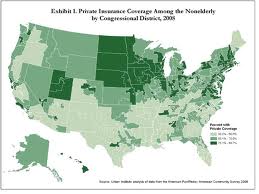 Where you live is a determining factor in whether you have health insurance.
Where you live is a determining factor in whether you have health insurance.
The darker green on the map illustrates states with the highest percentage penetration of people with private health insurance among people under 65. Note the concentration in the Upper Midwest, scattered Midwest, and bits of the northeast. It’s also helpful to live in Utah when it comes to health insurance coverage.
The lowest proportions of privately insured Americans are in much of the south, from Florida west to Texas and into southern New Mexico, Arizona and much of California.
The Urban Institute has studied health insurance coverage across Congressional districts and concludes that, indeed, geography is destiny. The Institute’s report, Variation in Insurance Coverage Across Congressional Districts, analyzes data from the 2008 American Community Survey, part of the U.S. Bureau of the Census data collection activities.
The bottom line is that private health insurance coverage is lowest in districts that have higher poverty rates.
Health Populi’s Hot Points: This second map illustrates the rate of uninsurance in each state. The darkest red represents the highest levels of uninsurance among people under 65. It’s clear these areas of highest uininsurance bleed from the south westward all the way up to the Canadian border.
The Institute punctuates its report with the conclusion that certain Congressional districts “would have the most to gain from health reforms that are designed to increase health insurance coverage toward a higher and more uniform national standard.”
This is one of the arguments for universal coverage: that Americans, regardless of geography or socioeconomic status, should have access to at minimum, a basic market basket of health services.




 I'm in amazing company here with other #digitalhealth innovators, thinkers and doers. Thank you to Cristian Cortez Fernandez and Zallud for this recognition; I'm grateful.
I'm in amazing company here with other #digitalhealth innovators, thinkers and doers. Thank you to Cristian Cortez Fernandez and Zallud for this recognition; I'm grateful. Jane was named as a member of the AHIP 2024 Advisory Board, joining some valued colleagues to prepare for the challenges and opportunities facing health plans, systems, and other industry stakeholders.
Jane was named as a member of the AHIP 2024 Advisory Board, joining some valued colleagues to prepare for the challenges and opportunities facing health plans, systems, and other industry stakeholders.  Join Jane at AHIP's annual meeting in Las Vegas: I'll be speaking, moderating a panel, and providing thought leadership on health consumers and bolstering equity, empowerment, and self-care.
Join Jane at AHIP's annual meeting in Las Vegas: I'll be speaking, moderating a panel, and providing thought leadership on health consumers and bolstering equity, empowerment, and self-care.